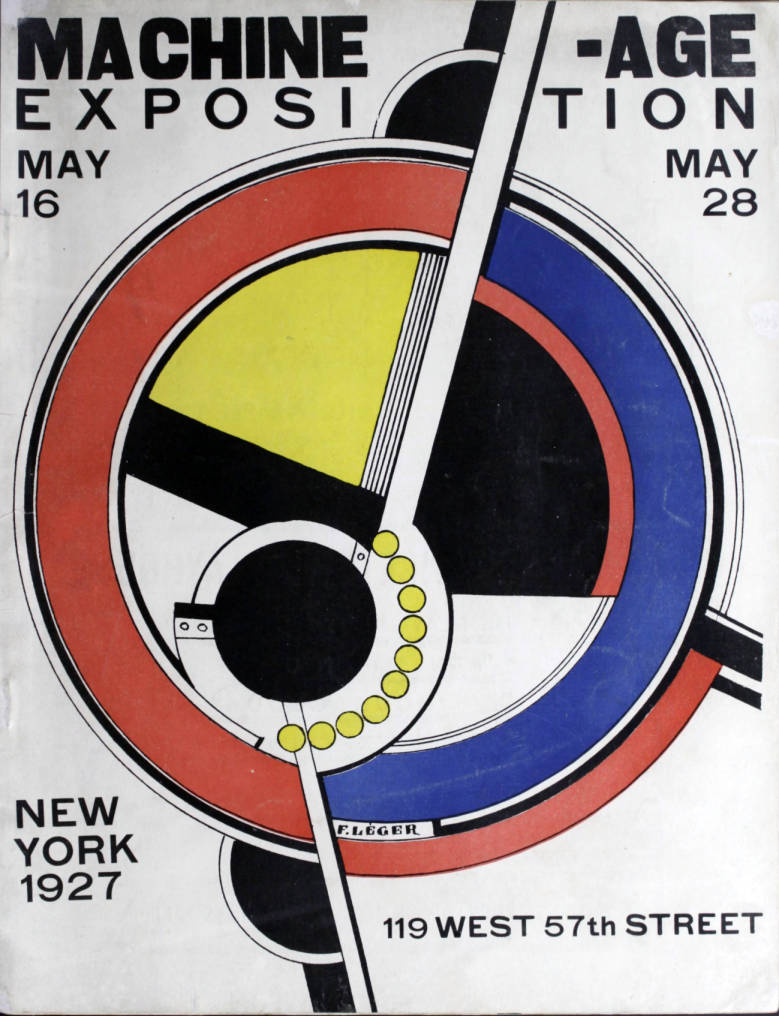Machine-Age Exposition, catalogue (1927)
Filed under catalogue | Tags: · architecture, art, avant-garde, constructivism, cubism, design, industrial design, machine


Poster, via Beinecke Rare Book & Manuscript Library
Exhibition catalogue of the Machine-Age Exposition, held on May 16-28, 1927, at 119 West 57th Street in New York, and advertised as the first event bringing together “architecture, engineering, industrial arts and modern art.”
The exhibition was initiated by Jane Heap of The Little Review, a New York literary magazine, and organised along with Société des urbanistes, Brussels; U.S.S.R. Society of Cultural Relations with Foreign Countries; Kunstgewerbeschule, Vienna; Czlonkowie Group Praesens, Warsaw; Architects D.P.L.G, Paris; and Advisory American Section.
The volume contains a panorama of European and American architecture and art, with photo documentation, and following articles: “Foreword: Architecture of this Age” by Hugh Ferriss, “The Aesthetic of the Machine and Mechanical Introspection in Art” by Enrico Prampolini, “Machine and Art” by Alexander Archipenko, “The Americanization of Art” by Louis Lozowick, “French Architecture” by André Lurçat, “Architecture Opens Up Volume” by Szymon Syrkus, “Machine-Age Exposition” by Jane Heap, “The Poetry of Forces” by Mark Turbyfill, and “Modern Glass Construction” by Frederick L. Keppler.
The artists committee of the exhibition included Alexander Archipenko, Robert Chanler, Andrew Dasberg, Charles Demuth, Muriel Draper, Marcel Duchamp, Josef Frank, Hugh Ferriss, Louis Lozowick, André Lurçat, Elie Nadleman, Man Ray, Boardman Robinson, Charles Sheeler, Ralph Steiner, Szymon Syrkus and L. Van der Swallmen.
Represented countries: “America”, Austria, Belgium, France, Germany, Poland and Russia.
Published in New York, 1927
44 pages
via Hagley Digital Archives
Commentary (E. B. White, The New Yorker, 1927): “That the machine is the tutelary symbol of the universal dynamism can be discovered at the Machine Age Exposition. […] Drawings, photographs, cubist and constructionist figures by reputable modern artists are side by side with cogs, motor boat propellers, Crane valves, insides of pianos and diving suits.”
Machine-Age Exposition at Monoskop wiki
Comment (0)Matthew Fuller, Andrew Goffey: Evil Media (2012)
Filed under book | Tags: · algorithm, art, artificial intelligence, business, code, computing, data, database, event, governance, information, interaction, interface, knowledge, labour, language, machine, management, market, media, media theory, memory, military, networks, philosophy, political theory, politics, power, programming, software

“Evil Media develops a philosophy of media power that extends the concept of media beyond its tried and trusted use in the games of meaning, symbolism, and truth. It addresses the gray zones in which media exist as corporate work systems, algorithms and data structures, twenty-first century self-improvement manuals, and pharmaceutical techniques. Evil Media invites the reader to explore and understand the abstract infrastructure of the present day. From search engines to flirting strategies, from the value of institutional stupidity to the malicious minutiae of databases, this book shows how the devil is in the details.
The title takes the imperative “Don’t be evil” and asks, what would be done any differently in contemporary computational and networked media were that maxim reversed.
Media here are about much more and much less than symbols, stories, information, or communication: media do things. They incite and provoke, twist and bend, leak and manage. In a series of provocative stratagems designed to be used, Evil Media sets its reader an ethical challenge: either remain a transparent intermediary in the networks and chains of communicative power or become oneself an active, transformative medium.”
Publisher MIT Press, 2012
ISBN 0262304406, 9780262304405
235 pages
Review: Nicholas Holm (Media Int’l AU, 2013), Neural (2013).
Evil media on Monoskop wiki
PDF (updated on 2024-4-13)
HTML (added on 2015-8-28)
See also YoHa, et al., Evil Media Distribution Centre, 2013.
Comments (2)Wolfgang Ernst: Digital Memory and the Archive (2012)
Filed under book | Tags: · archive, art, communication, computing, culture, data, history, information, internet, knowledge, machine, media, media archeology, media studies, media theory, memory, photography, radio, sound, storage, technology, television, temporality, time

“In the popular imagination, archives are remote, largely obsolete institutions: either antiquated, inevitably dusty libraries or sinister repositories of personal secrets maintained by police states. Yet the archive is now a ubiquitous feature of digital life. Rather than being deleted, e-mails and other computer files are archived. Media software and cloud storage allow for the instantaneous cataloging and preservation of data, from music, photographs, and videos to personal information gathered by social media sites.
In this digital landscape, the archival-oriented media theories of Wolfgang Ernst are particularly relevant. Digital Memory and the Archive, the first English-language collection of the German media theorist’s work, brings together essays that present Ernst’s controversial materialist approach to media theory and history. His insights are central to the emerging field of media archaeology, which uncovers the role of specific technologies and mechanisms, rather than content, in shaping contemporary culture and society.
Ernst’s interrelated ideas on the archive, machine time and microtemporality, and the new regimes of memory offer a new perspective on both current digital culture and the infrastructure of media historical knowledge. For Ernst, different forms of media systems—from library catalogs to sound recordings—have influenced the content and understanding of the archive and other institutions of memory. At the same time, digital archiving has become a contested site that is highly resistant to curation, thus complicating the creation and preservation of cultural memory and history. ”
Edited and with an Introduction by Jussi Parikka
Publisher University of Minnesota Press, 2012
Volume 39 of Electronic Mediations
ISBN 0816677670, 9780816677672
265 pages
Reviews: Liam Cole Young (Reviews in Cultural Theory, 2013), Peter Ward (Information & Culture, 2014).
For more from Wolfgang Ernst see Monoskop wiki.
Comment (0)
